22 3.4. The Brain and Spinal Cord
The central nervous system is the control center for our thoughts, feelings, and behaviors. The brain is the “boss” of the whole system, it is a complex organ comprised of billions of interconnected neurons and glia, and is capable of very sophisticated processing. The spinal cord, on the other hand, is a simpler structure. It relays messages back and forth to the brain, but it also controls basic, automatic behaviors known as reflexes.
SPINAL CORD
The spinal cord is functionally organized into 31 segments; each segment is encased within one of the vertebrae (bones) of the spine for protection (Figure 3.11a).

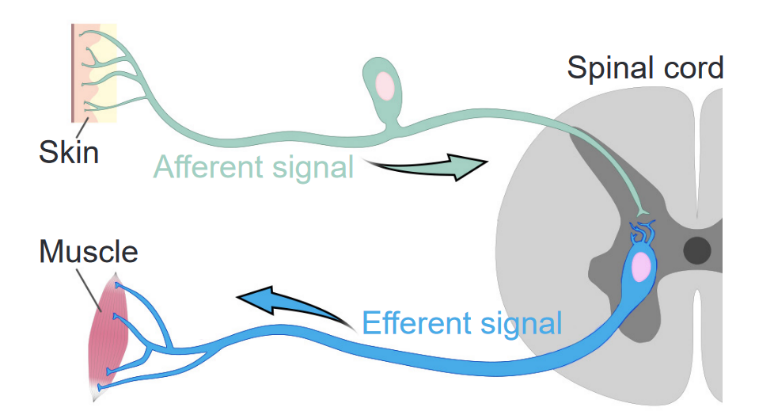
The spinal cord (like the brain) is also cushioned in cerebrospinal fluid. There are 8 cervical segments, 12 thoracic segments, 5 lumbar, 5 sacral, and one coccygeal (not shown in Figure 3.11a, but it is located at the base of the spine). The spinal cord connects to rest of the body via the peripheral nervous system, in the following ways. Each spinal cord segment connects to a sensory nerve and a motor nerve that serve a specific part of the body; thus, there are 31 pairs of spinal nerves. Sensory nerves bring messages into the spinal cord, which are then sent to the brain. The brain also sends messages to the spinal cord, which are conveyed via motor nerves to the muscles, glands, and organs (Figure 3.11b) Figure 3.11a shows the connections between each spinal cord segment and the specific body areas it serves. The cervical segments connect to muscles in the face, head, neck, shoulders, arms and hands, as well as the diaphragm that controls our breathing. The thoracic segments connect to the middle trunk area, the intercostal muscles between the ribs, and the abdominal muscles. The lumbar segments connect to the hips and legs, and the sacral regions to the toes, backs of the thighs and pelvis. The coccygeal segment sends information to and from the tailbone area.
Reflexes
Clearly, the spinal cord is an important relay station between the brain and the rest of the body. However, the spinal cord is also able to initiate some basic behaviors in direct response to sensory messages, without any input from the brain. These very rapid automatic responses are called reflexes and are mostly protective. They include the actions of moving quickly away from a hot object and blinking your eye(s) when something comes too close to them.
Reflexes are controlled by very simple neural circuits called reflex arcs. In a reflex arc, information (e.g., sensing when something is hot) passes from the outside world via the sensory nerve to an interneuron in the spinal cord, this then sends a command via a motor neuron to a muscle (Figure 3.12). There are only three neurons are involved in the circuit—a sensory neuron, interneuron and a motor neuron. The distance between the sensory and motor neurons is very small because the interneuron is tiny. Consequently, the time between receiving the information and responding to it is extremely fast. Of course, the spinal cord does ultimately send the information to the brain as well, so we are aware of what has happened. However, if we had to wait for the brain to respond, it would take a lot longer for the action to occur. The information would have to travel up the spinal cord to the brain where it would be processed, and then the brain would send a command down the spinal cord to the motor neuron and then to the muscle.
Because the brain is not involved in simple reflexes, it is possible to have brain damage where the reflexes are unaffected. The parts of the body that are affected by spinal cord injuries depend on the location of the damage. Damage in the upper parts of the spinal cord will have more serious consequences than damage lower down. This is because the damage will not only affect the part of the body that segment serves (see Figure 3.11a), but all the axons from all the lower segments have to pass through this area too, so they are cut off from the brain, causing widespread paralysis and lack of sensory input.

Brainstem
The brainstem sits on top of the spinal cord and contains the medulla and the pons. The medulla controls primitive but vital life-support functions, such as breathing, blood pressure, and heart rate. The word pons literally means “bridge,” and as the name suggests, the pons is a crossing point for many axons traveling back and forth to the brain. It also is involved in regulating brain activity during sleep (see Figure 3.13).
Cerebellum
The cerebellum (Latin for “little brain”) is a structure that is located close to the brainstem because it developed from the same general area in the fetal brain (see Figure 3.13). It receives messages from muscles, tendons, joints, and structures in our ear to control balance, coordination, movement, and motor skills. The cerebellum is also thought to be an important area for procedural memories, which are actions that we do not consciously think too much about, like walking, brushing our teeth, and riding a bike. The basal ganglia also contribute to procedural memories.
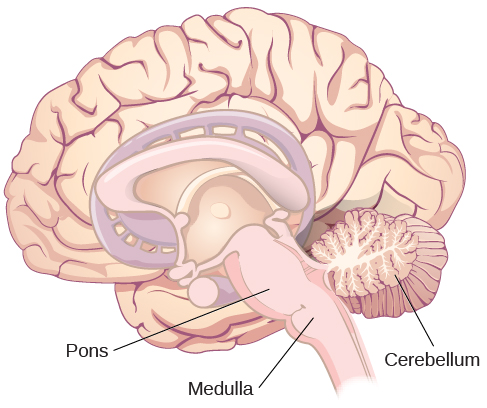
Midbrain
The midbrain extends up from the brain stem. Midbrain structures are located deep within the brain and are not visible from the surface, again they have fairly primitive functions. The reticular formation, which is important in regulating sleep/wake cycles, arousal, alertness, and motor activity, passes through the midbrain as it sends messages back and forth between the brainstem and higher brain areas, like the cerebral cortex.
The substantia nigra (Latin for “black substance”) and the ventral tegmental area (VTA) are also located in the midbrain, Figure 3.14). Both regions contain cell bodies that produce the neurotransmitter, dopamine. The substantia nigra and VTA along with other interconnected brain structures are collectively known as the basal ganglia. The basal ganglia are critical for movement, and are also involved in mood, reward, and addiction behaviors (Berridge & Robinson, 1998; Gardner, 2011; George et al., 2012). Degeneration of the substantia nigra and VTA is involved in Parkinson’s disease.
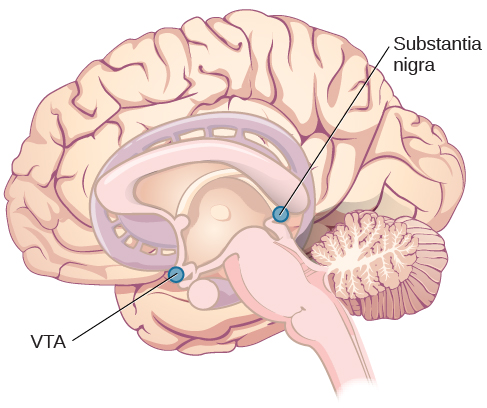
Other important subcortical areas
Other important structures that lie beneath the surface of the brain include the thalamus and the limbic system. The thalamus sits on top of the midbrain structures and relays information from all of our senses, with the exception of smell, to other areas of the brain for processing (Figure 3.15). It is often referred to as a sensory switchboard.
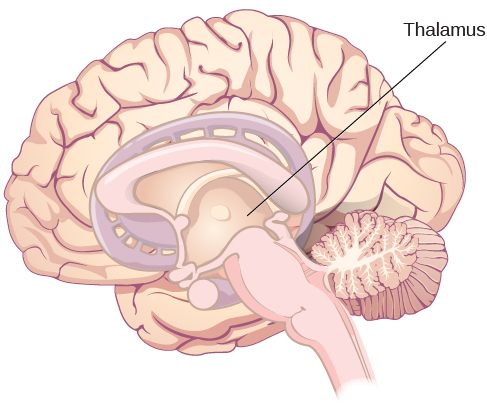
The limbic system is involved in processing information relating to both emotion and memory. Interestingly, the sense of smell projects to the limbic system; therefore, not surprisingly, smell can evoke emotional responses in ways that other sensory modalities do not. The limbic system is made up of a number of different structures, including the hippocampal structures, the amygdala, and the hypothalamus (Figure 3.16). The hippocampus is an essential structure for learning and memory. The amygdala is active when experiencing emotion and is important for tying emotional meaning to our memories. The hypothalamus regulates a number of homeostatic processes, including the regulation of body temperature, appetite, and blood pressure. The hypothalamus also serves as an interface between the nervous system and the endocrine system and in the regulation of sexual motivation and behavior.
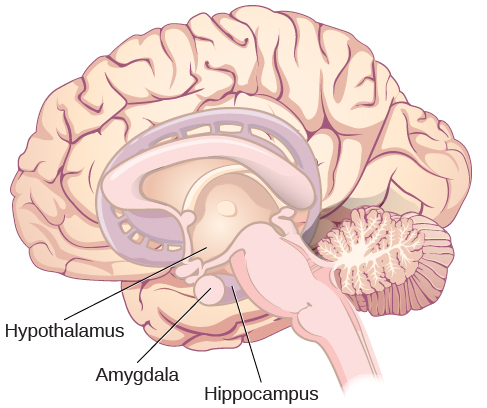
The Case of Henry Molaison (H.M.)
In 1953, surgeons performed experimental brain surgery on Henry Gustav Molaison (H. M.). He was a 27-year-old man who been experiencing severe epileptic seizures since he fell off his bicycle as a child. Surgeons removed the hippocampal structures and much of the amygdala from both sides of his brain. After the surgery, H. M’s seizures became much less severe, but he also suffered some unexpected and devastating consequences of the surgery. He was no longer able to form most types of new memories. For example, he was unable to learn new facts. He could not remember new faces, and he was unable to remember anything that someone had said to him for more than about 30 seconds. He was able to learn new motor skills, such as drawing while looking in a mirror, but afterward he had no recollection of learning how to do it. Researchers were fascinated by his experience, and he is considered one of the most famous case studies in medical and psychological history (Hardt, Einarsson, & Nader, 2010; Squire, 2009). His case provided vital insights as to the importance of the hippocampal structures for explicit memories.
Link to Learning
Clive Wearing, an accomplished musician, lost the ability to form new memories when his hippocampus was damaged when a virus affected his brain. Check out the first few minutes of this documentary video about this man and his condition to learn more.
The Two Hemispheres of the Brain
Probably the most noticeable feature of the brain is its wrinkly surface, this is a thin layer of cells called the cerebral cortex. The cerebral cortex has a distinctive pattern of bumps, known as gyri (singular: gyrus), and grooves, known as sulci (singular: sulcus), shown in Figure 3.17. The cerebral cortex is associated with higher level processes such as consciousness, thought, emotion, reasoning, language, and memory. Its wrinkled structure allows more cells to be packed into a smaller area; if it were flattened out—it would be about the size of a pillow case and we would need to have much larger skulls to accommodate this! The structures that we have already discussed in this chapter are housed below the cerebral cortex which is why we refer to them as subcortical structures. They perform more basic functions than the cortex.
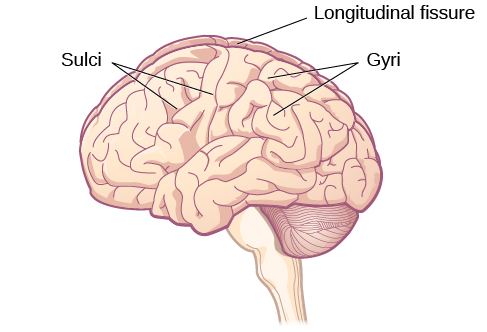
Brain Lateralization
The brain has two halves called hemispheres that are divided by the longitudinal fissure. The two sides of the brain work in concert together, however, each side of the brain is somewhat specialized for some functions. For example, we know that each hemisphere controls the opposite (contralateral) side of the body. So, people with damage to their left motor cortex will have paralysis in the right side of their body. Dr. Michael Gazzaniga and his colleagues have performed decades of research on lateralization of brain function, largely based on studies performed with split-brain patients (Gazzaniga, 2005).
Split brain patients
The right and left hemispheres are interconnected by the corpus callosum, a thick band of about 200 million axons. The corpus callosum allows information being processed on one side of the brain to be shared with the other side. In some cases of severe epilepsy, doctors elect to sever the corpus callosum as a means of controlling the spread of seizures (Figure 3.18). While this is an effective treatment option, it results in “split brain” behaviors after surgery. In a “split-brain”, the two sides of the brain do not communicate with each other. Therefore, split-brain patients are good at using their hands independently, for example, they are able to simultaneously draw a circle with one hand and a square with the other. Give it a try—it’s not as easy as it sounds!

In a lab setting, we can also use a technique known as hemi-field presentation that capitalizes on the anatomical arrangement of the visual pathways to present information to each hemisphere of the brain separately (Figure 3.19). If we stare at a center spot on a computer screen – information to the right of the spot (i.e., the right visual field of each eye) goes to the left side of the brain and information on the left of the spot (left visual field) goes to the right side of the brain Figure 3.19). In typical healthy brains, this information is quickly shared across the corpus callosum but in a split-brain patient, the information stays within each hemisphere. Thus, split brain patients provide scientists with a way to study the function of each hemisphere separately. Split-brain studies have shown that for most people, the left hemisphere is responsible for speech production. This finding comes from hemi-field studies where split-brain people are shown different pictures on each side of the screen. If a split brain person looks at a picture with a key in the left visual field (sent to right hemisphere) and a ring in the right visual field (sent to left hemisphere) and are asked what they see, they would say that they only saw a ring. However, if they were asked to draw what they saw with their left hand, which is also controlled by the right hemisphere, they would draw the key (Figure 3.19).
Other studies with split brain patients show that the right hemisphere is better at recognizing faces than the left hemisphere, and is more likely to process information holistically rather than in terms of its individual parts. For example, showing a picture like the one by the artist, Arcimboldo, depicted in Figure 3.20, gives rise to different perceptions depending on which visual field it is shown in. If shown in the left visual field (right hemisphere) split brain patients are likely to perceive a face, but if it is shown in the opposite visual field, they are more likely to perceive the individual elements that the face is made from, such as the fruits and the flowers.
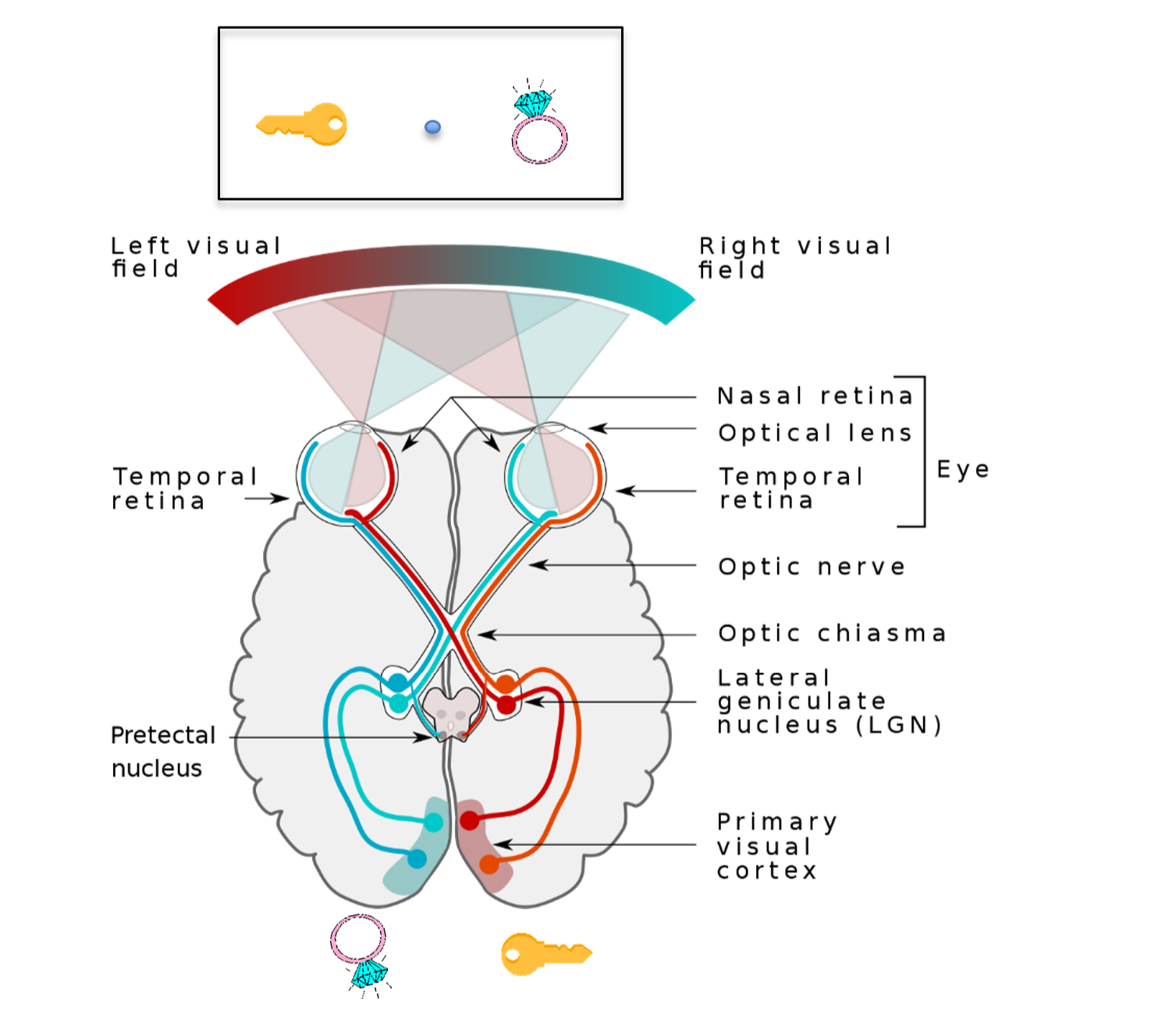

Lobes of the Brain
The brain can be divided into four lobes called the frontal, parietal, temporal, and occipital lobes (Figure 3.21). Each of the four lobes is somewhat specialized in terms of its function. However, many thoughts, feelings, and behaviors activate networks of neurons across the four lobes.
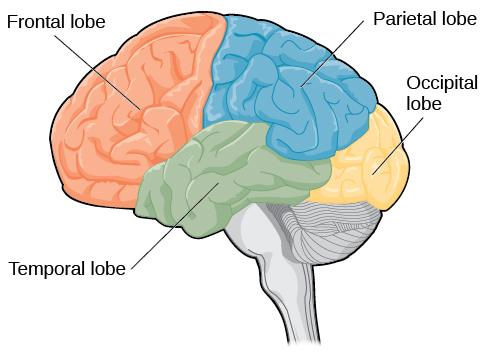
Frontal Lobe
The frontal lobe is located in the most anterior part of the brain at the front of the head, and extends back to the central sulcus. The frontal lobe is involved in reasoning, emotion, and language. It is subdivided into many different regions, including the motor cortex (Figure 3.22a), which is involved in planning and coordinating movement; the prefrontal cortex, which is responsible for higher-level cognitive functioning; and Broca’s area (Figure 3.22b), which is essential for language production. People who suffer damage to Broca’s area have great difficulty producing language of any kind (Broca’s aphasia). For example, Padma was in a car accident and sustained damage to her Broca’s area. She completely lost the ability to speak and form any kind of meaningful language. There is nothing wrong with her mouth or her vocal cords, but she is unable to produce words. She can follow directions but can’t respond verbally, and she can read but no longer write. She can do routine tasks like running to the market to buy milk, but she cannot ask for assistance in the store.

![Polygon data were generated by Database Center for Life Science(DBCLS)[2]., CC BY-SA 2.1 JP, via Wikimedia Commons. https://commons.wikimedia.org/wiki/File:Broca%27s_area_-_lateral_view.png image](https://pressbooks.cuny.edu/app/uploads/sites/217/2023/08/image27.png)
Probably the most famous case study of prefrontal lobe damage is the story of Phineas Gage. In1848, Gage (age 25) was working as a railroad foreman in Vermont. He and his crew were using an iron rod to tamp explosives down into a hole to remove rock along the railway’s path. Unfortunately, the iron rod created a spark and caused the rod to explode out of the hole, through Gage’s left cheek and out of the top of his skull (Figure 3.23). Gage quickly regained consciousness and was able to get up, walk, and speak. But in the months following his accident, people noticed that his personality had changed. Before the accident, Gage was a well-mannered, soft-spoken man, but afterwards, he became uncaring and unreliable, and frequently used inappropriate language. These changes in personality are consistent with the loss of impulse control—a prefrontal cortex function (Macmillan, 1999). Figure 3.23.c depicts a reconstruction of the brain damage that the iron rod caused in Phineas Gage.
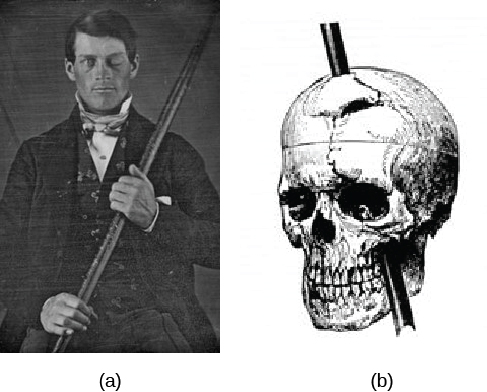

Parietal Lobe
The brain’s parietal lobe is located immediately behind the frontal lobe, and is involved in attentional processes and processing somatosensory information such as touch, temperature, and pain. Each part of your body sends information to a particular area of the primary somatosensory cortex, so it is organized like a map. Body parts that are very sensitive (like our lips) have many sensory neurons and so send a lot of information to the brain. Consequently, the lips take up more space in the primary somatosensory cortex compared to a less sensitive, but larger body part, like a leg (Figure 3.24).

Temporal lobe
The temporal lobes are located on each side of the head and are associated with hearing, memory, emotion, and language comprehension. The primary auditory cortex, the first cortical area that processes auditory information, is located within the temporal lobe. Wernicke’s area, which is important for speech comprehension, is located nearby. Whereas individuals with damage to Broca’s area have difficulty producing language, those with damage to Wernicke’s area have difficulty understanding language (Figure 3.25). People with Wernicke’s aphasia can pronounce words. However, what they say does not make sense and is often referred to as word salad.
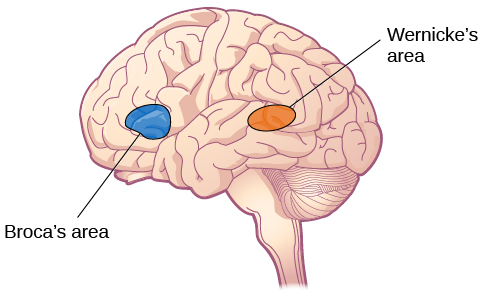
Occipital Lobe
The occipital lobe is located at the very back of the brain, and contains the primary visual cortex, which is the first cortical area to receive and process visual information. As you saw earlier when reading about hemi-field presentations of visual information, the occipital cortex is organized such that each hemisphere receives information from each visual field of each eye (Figure 3.19). You will learn more about how visual information is processed in the occipital lobe when you read about sensation and perception in an upcoming chapter.
Brain Imaging
Although early studies of the brain focused on case studies of patients with brain damage, there are now multiple different ways to image brains. This allows scientists to study healthy brains too. Some techniques provide information about the layout of the physical structures of the brain, these are called structural imaging techniques. They are useful for understanding the anatomy of the brain, locating areas of damage or measuring the size of tumors etc. Other techniques measure which part of the brain is active or how the brain processes different kinds of information, these are called functional imaging techniques. Researchers use functional brain imaging to learn about how the brain works.
CT scans
A computerized tomography (CT or CAT) scan involves taking multiple x-rays of a particular section of a person’s body or brain from different angles (Figure 3.26). The x-rays pass through tissues of different densities at different rates, allowing a computer to construct a detailed structural image (Figure 3.27). A CT scan is useful for identifying the location and size of damage or tumors.


PET scans
Positron emission tomography (PET) scans are functional brain scans because they create pictures of the living, active brain (Figure 3.28a and b). An individual receiving a PET scan drinks, inhales or is injected with a mildly radioactive substance, called a tracer. Common tracers include glucose and oxygen. Once in the bloodstream, the amount of tracer in any given region of the brain can be monitored. As a brain area becomes more active, more blood flows to that area. This technique was frequently used to assess whether tumors are metabolically active or benign. PET scans are sometimes used in conjunction with CT scans to provide better information about the location of the tumor. CT scans contribute clear images of brain structures, while PET scans show the brain’s activity. This combined technique is also useful for studies looking at how psychological disorders affect neurotransmitter function. PET scans can create a rough map of active and inactive areas of the brain during a given behavior, e.g., listening to someone speaking compared to listening to white noise. However, PET scans lack detail, are unable to pinpoint events precisely in time, and require that the brain be exposed to radiation. Therefore, these kinds of research studies now use fMRI instead.

Magnetic resonance imaging (MRI) and fMRI
In magnetic resonance imaging (MRI), a person lies inside a scanner that generates a strong magnetic field (Figure 3.29a). The hydrogen atoms in the body’s cells align with the magnetic field. Then a radio wave is turned on, which knocks the hydrogen atoms off their alignment, when the radio wave is turned off, the hydrogen atoms emit electromagnetic signals as they return to their original positions. Tissues of different densities give off different signals, which a computer interprets and displays on a monitor giving highly detailed anatomical images of the structures of the brain (Figure 3.29b). MRI provides more detailed images of the brain than CT scans, and does not expose participants to radiation, but it is more expensive.
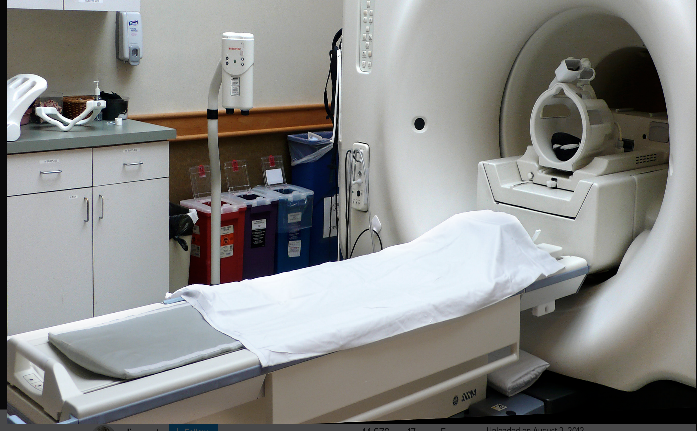

fMRI
Functional magnetic resonance imaging (fMRI) operates on the same principles as MRI, but it tracks blood flow and oxygen levels as a measure of brain activity. So, while MRI tells us about structure, fMRI tells us about function. fMRI scans (Figure 3.30) are safer and provide more detailed information than PET scans. Brain activity on an fMRI is usually shown in different colors, which are then superimposed on an MRI scan. In Figure 3.30, the scale shows us that the yellow regions are more active than the orange and red ones for this particular task comparison.

The data in Figure 3.30 come from an emotional Stroop study where participants were asked to look at emotional faces with a word superimposed on them (Figure 3.31). In half of the stimuli, the words matched the facial expression, these are called congruent stimuli, and for the half, the words and expressions did not match, these are called incongruent stimuli. In one part of the study, participants were asked to identify the facial expression and in the other part of the study, they identified the word. Participants were faster and more accurate when the label matched the facial expression. Figure 3.30 shows the increased activity that occurs for incongruent (non-matching) compared to congruent (matching) stimuli, which we can see is mostly in the frontal lobe. We can see that one of active areas is the left inferior frontal gyrus (IFG), also known as Broca’s area, which activates when people speak or think about speaking.

Electroencephalography (EEG) and Event-related Potentials (ERPs)
In some situations, it is helpful to understand how the brain is processing information without needing information on the actual location of the activity. Electroencephalography (EEG) provides this information by measuring the electrical activity produced by the brain. In EEG recording, electrodes are placed on a person’s head using conductive gel (Figure 3.32a). The signals received by the electrodes are displayed on a computer screen and show how the brain voltage changes over time, with an accuracy within milliseconds (Figure 3.32b). EEG recordings are especially helpful to researchers studying sleep patterns among individuals with sleep disorders and for studies of epilepsy.


Researchers also use EEG technology to study changes in brain activity in response to different kinds of stimuli. These averaged electrical brain responses are often referred to as brain waves or event-related potentials (ERPs). For example, the emotional Stroop stimuli described in Figure 3.31 were also used in an ERP study by a different group of researchers (Zhu et al., 2018). The ERP study provides information about the timing of the increased effort needed to process conflicting information—when the label and facial expression do not match. Sad faces with incongruent labels produced larger P3 brain waves (positive brain waves starting about 300 ms after seeing the face) compared to sad faces with the correct label. This difference in neural effort was apparent starting around 300 milliseconds after seeing the face/label combination (see Figure 3.33).

Neuroplasticity
Although new neurons are only found in a few locations (hippocampus and olfactory bulb) in the central nervous system after we are born, the nervous system is plastic – meaning that it can change and adapt. In fact, it is constantly changing and adapting. Neuroplasticity occurs in response to personal experiences as we learn new things. It often involves the creation of new synapses, pruning of synapses that are no longer used and changes in glial cells. However, neuroplasticity can also occur in response to damage or injury. Our brains are most plastic when we are young, but even older people, who suffer brain damage, such as from a stroke often recover at least partially, especially with the help of therapy.
One remarkable story relating to neuroplasticity is that of Bob Woodruff, a reporter for ABC, who suffered a traumatic brain injury after a bomb exploded next to the vehicle he was in while covering a news story in Iraq. Woodruff was put in a medical coma for 36 days to reduce his brain swelling. However, as a consequence of his injuries, Woodruff experienced many cognitive problems, including difficulties with memory and language. However, over time and with the aid of intensive amounts of cognitive and speech therapy, Woodruff has shown an incredible recovery of function (Fernandez, 2008). Mostly neuroplasticity is helpful. But, in some cases, the changes that occur in the brain in response to injury can cause further problems, such as phantom limb syndrome, where people experience pain in a limb that has been amputated.
Link to Learning
Learn more about Bob Woodruff’s story here
Link to Learning
Check out this NPR segment about amputees’ experiences of “phantom limbs” following amputation to learn more.
Brain Dead and on Life Support
What would you do if a loved one was declared brain dead but their body was being kept alive by medical equipment? Whose decision should it be to remove a feeding tube? Should medical care costs be a factor?
On February 25, 1990, a Florida woman named Terri Schiavo went into cardiac arrest, apparently triggered by a bulimic episode. She was eventually revived, but her brain had been deprived of oxygen for a long time. Brain scans indicated that there was no activity in her cerebral cortex, and she suffered from severe and permanent cerebral atrophy. Schiavo was diagnosed as being in a vegetative state. Medical professionals determined that she would never again be able to move, talk, or respond in any way. To remain alive, she required a feeding tube, and there was no chance that her situation would ever improve.
On occasion, Schiavo’s eyes would move, and sometimes she would groan. Despite the doctors’ insistence to the contrary, her parents believed that these were signs that she was trying to communicate with them.
After 12 years, Schiavo’s husband argued that his wife would not have wanted to be kept alive with no feelings, sensations, or brain activity. Her parents, however, were very much against removing her feeding tube. Eventually, the case made its way to the courts, both in the state of Florida and at the federal level. By 2005, the courts found in favor of Schiavo’s husband, and the feeding tube was removed on March 18, 2005. Schiavo died 13 days later.
Why did Schiavo’s eyes sometimes move, and why did she groan? Although the parts of her brain that control thought, voluntary movement, and feeling were completely damaged, her brainstem was still intact. Her medulla and pons maintained her breathing and caused involuntary movements of her eyes and the occasional groans. Over the 15-year period that she was on a feeding tube, Schiavo’s medical costs may have topped $7 million (Arnst, 2003).
Decisions surrounding the medical response to patients declared brain dead are complex. What do you think about these issues?
